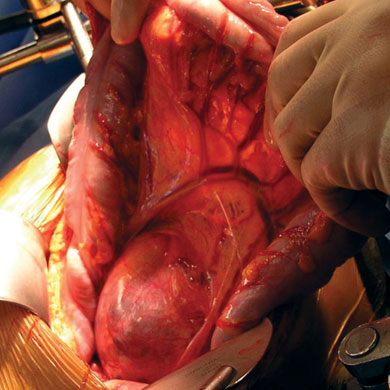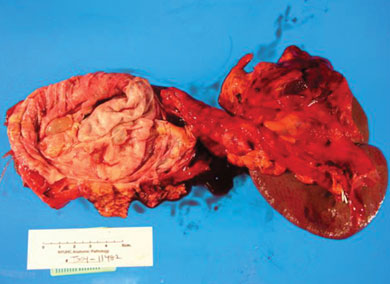My Patient Has a Large Pancreatic Cyst. Should I Involve a Surgeon in the Evaluation and Management of This Situation?
Click Here to Manage Email Alerts
Pancreatic cystic lesions are being diagnosed with increasing frequency in asymptomatic patients or incidentally through investigation of an unrelated presenting symptom. With the standard use of cross-sectional imaging, such as computed tomography (CT) or magnetic resonance imaging (MRI), pancreatic cystic lesions are found more commonly than previously reported. Furthermore, through expanding expertise at tertiary care centers as well as in the community setting, endoscopic ultrasound (EUS) evaluation and classification of pancreatic cystic lesions has become possible without the need for surgical extirpation. These imaging modalities allow the treatment algorithm used by most gastroenterologists and pancreatic surgeons to focus on the differentiation of benign cysts from those cysts that are malignant or have malignant potential.
Historically, the majority of fluid collections associated with the pancreas have been classified as pseudocysts or inflammatory in nature. During the evaluation of a patient newly diagnosed with a pancreatic cyst, a history of acute pancreatitis is essential to exclude and therefore virtually eliminate pseudocyst from the differential diagnosis. As diagnostic techniques have expanded, many of these previously misclassified fluid collections are now being appropriately diagnosed as a pancreatic cystic neoplasm. For the remainder of this chapter, I will not focus on pseudocysts or congenital simple cysts of the pancreas. My goal is to help you differentiate benign from malignant cysts of the pancreas and clarify their management based on anatomical location and malignant potential. Benign cystic neoplasms are called serous or microcystic cystadenomas. Cysts that are malignant or have premalignant potential are classified as mucinous cystadenomas ([MCNs] macrocystic adenoma), mucinous cystadenocarcinoma, side-branch or main duct intraductal papillary mucinous neoplasm (IPMN), solid-pseudopapillary neoplasm, or more rarely a cystic neuroendocrine or cystic ductal adenocarcinoma.
Cysts of the tail of the pancreas are able to be managed with distal pancreatectomy, spleen-sparing or associated with splenectomy (Figure 29-1). In carefully selected patients, cysts of the body and tail are able to be removed with laparoscopic distal pancreatectomy, again with or without splenectomy (Figure 29-2). If symptoms are present, operation should be recommended in the fit patient. Cystic lesions of the pancreatic body or tail that are incidentally found in the asymptomatic patient through investigation of another condition warrant further investigation. For these asymptomatic patients, a minimum of CT and EUS with aspiration should be performed. If characteristics of a mucinous tumor are identified based on imaging characteristics or cyst fluid analysis obtained via EUS aspiration, operation should be recommended. For IMPN, particularly the main-branch variant, margin analysis with intraoperative frozen section is imperative to rule out dysplasia and therefore the appropriate extent of resection. Due to a reported high morbidity rate, I feel that laparoscopic distal pancreatectomy should be an option only at an experienced pancreatic surgery center.

Figure 29-1. Pancreatic tail cyst as seen through the mesentery.

Figure 29-2. Specimen of resection leading to splenectomy due to infiltration of the splenic vein by the cystic mass.
Cysts located in the head of the pancreas are resected with standard or pylorus-preserving pancreaticoduodenectomy. Patients presenting with pain or jaundice warrant resection. For the asymptomatic patient, investigation is similar to that for the asymptomatic lesion of the body/tail described above. For patients found to have mucinous cysts of the head of the pancreas, I feel that pylorus preservation provides better gastric function and long-term quality of life without infringing on the oncologic principles of the resection.
For the rare cyst of the neck of the pancreas, a central pancreatectomy may be employed as the procedure for cyst excision. The benefits of central pancreatectomy focus on pancreatic parenchymal preservation. Caution must be used when recommending and performing central pancreatectomy. First, it is of utmost importance to ensure the benign or low malignant potential nature of the lesion due to the oncologic limitations of central pancreatectomy. Second, several high-volume pancreatic centers have documented a high morbidity rate associated with central pancreatectomy. I feel that only experienced pancreatic surgeons at high-volume centers should be involved in the selection and care of these unique patients.
The decision to operate on a tail or head cyst is multifactorial and must account for patient-presenting symptoms, CT and EUS findings, and cyst fluid analysis. In my mind, I do not necessarily change my diagnostic algorithm based on cyst location alone. At high-volume centers, pancreaticoduodenectomy and distal pancreatectomy are able to be performed with very low morbidity and mortality rates. More importantly, both patient and cyst factors must play a role. Patient fitness must be accounted for but in suitable operative candidates, operative resection should be performed in the symptomatic patient. For borderline candidates or those that are asymptomatic, further investigation to determine the nature of the cystic neoplasm is warranted. CT may reliably differentiate a serous from MCN or IPMN. EUS may be used to evaluate the cystic neoplasm and obtain fluid for cytology, carcinoembryonic antigen (CEA) level analysis, and mucin stain. The presence of mucin or a high CEA level (>192) suggests a mucin-producing or premalignant tumor that warrants resection. EUS also allows evaluation of the cyst wall for the presence of papillary projections or mural nodules, both of which should lead one toward operative excision.
In summary, once a cystic lesion is identified in the pancreas, operative excision should be recommended for the symptomatic patient. In patients who are asymptomatic, further investigation should be performed in order to differentiate a serous (benign) from a mucinous (malignant or premalignant) cystic neoplasm. For mucinous or suspicious cystic lesions, operative excision should be recommended in fit candidates. A team consisting of an experienced pancreatic surgeon, CT radiologist, and pancreatic endoscopic ultrasonographer is critical to completely and appropriately evaluate the increasing number of patients diagnosed with a pancreatic cystic neoplasm.
Bibliography
Baron TH, Adler DG, et al. ASGE guideline: the role of endoscopy in the diagnosis and the management of cystic lesions and inflammatory fluid collections of the pancreas. Gastrointest Endosc. 2005;61(3).
Brugge WR, Lewandrowski K, et al. The diagnosis of pancreatic cystic neoplasms: a report of the cooperative pancreatic cyst study. Gastroenterology. 2004;126:1330-1336.
